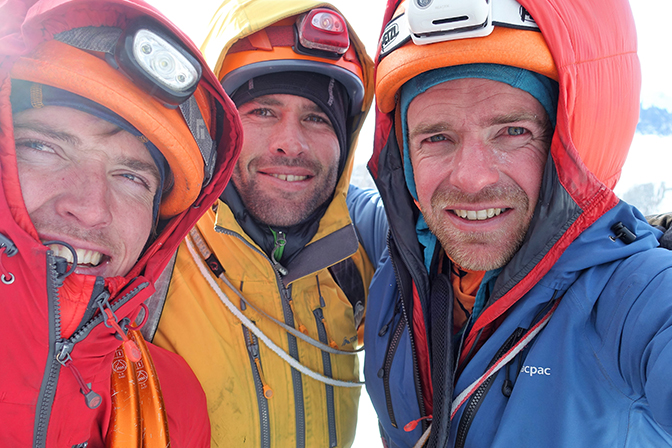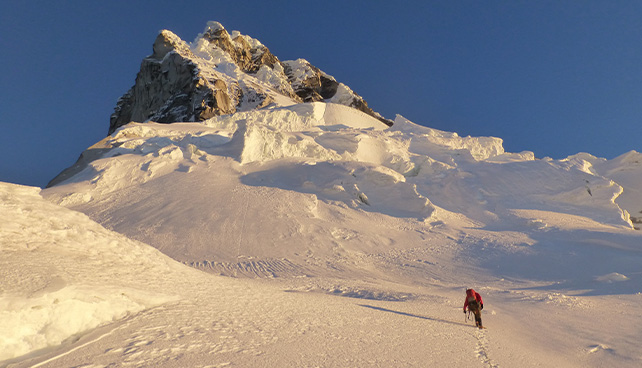
The New Zealand Alpine Team is a group of mountaineers whose reputation has been carved out in some of the world’s gnarliest alpine environments. Since 2013, the NZAT has chosen to take Macpac with them on their expeditions, providing our design team with a constant and invaluable stream of research and development feedback. Their field notes inform the design of each new addition to the Macpac Alpine Series – the products we design specifically for mountaineering and extreme conditions. The following is an excerpt the from the New Zealand Alpine Team 2018 Patagonia expedition journal, chronicling their assault on Punta Herron.
After forty hours in transit, the Fitzroy alpine skyline finally came into view through the minivan windscreen. We felt strangely at home. In our minds, we were cruising alongside Lake Pukaki en route to Mt. Cook, the cloud piercer smouldering in another northwest storm. But that was a comfortable daydream – I quickly realised this massif was the Southern Alps on steroids, and the approaches alone would be equivalent to an ascent of Aoraki. But this is the challenge we’d dreamt of.
Our team was; Dan Joll, eight-time Patagonian veteran; Caleb Jennings, the packhorse from Darfield; and me, Alastair McDowell, an NZAT mentee. We arrived in El Chalten, the starting point for the expedition. While more sensible alpinists waited in town for the perfect weather, the three of us spent a full day tent-bound at our basecamp in Niponino, up the Torre Valley, ready to pounce as soon as the barometer spiked. This was mountaineering, Kiwi style.
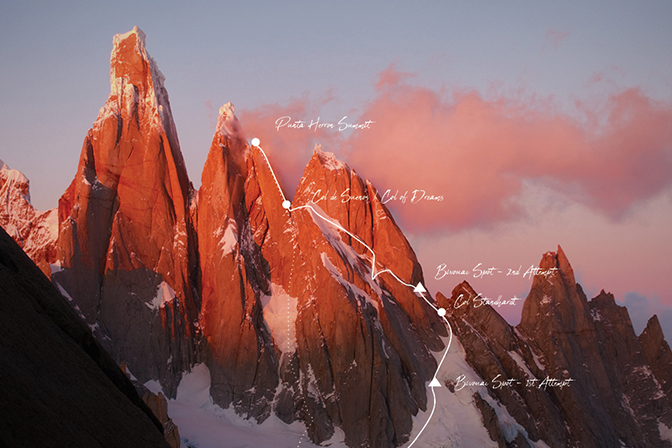
Solid line – asscent. Broken line – descent. The Fitzroy Massif Skyline, Patagonia | Winter Journal
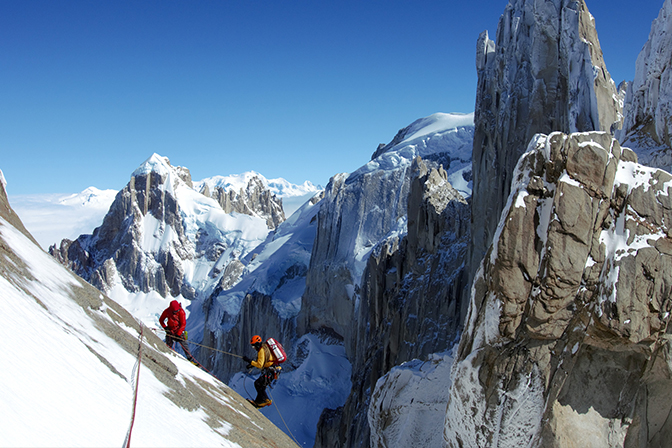
Lowering out, 40m above Col Standhardt | Winter Journal
A promising four day weather window appeared on the radar, and we started to dream big. This was our chance to attempt the main objective; Punta Herron. We set out for the foot of Standhardt Col at 7pm, but to our disappointment and contrary to the forecast, snow fell without relief. Around midnight we found ourselves high on the glacier below Standhardt, postholing through deep snow, the risk of avalanche ever present. Under the relentless snowfall there was no possibility of climbing that night. Instead, we pitched camp, digging in on a relatively sheltered position. Avalanches shook past our tent. Fear kept sleep at arms length until morning. We were forced to wait an entire day before conditions eased.
The weather cooperated right up until we reached the base of Punta Herron, where poor conditions set in again. Our first glimpse of Punta Herron was bittersweet – a majestic face looked back at us, but it cascaded with near-freezing water that would soon set in a shield of unclimbable verglas as temperatures plummeted. We were gutted – there was no choice but to turn back. Twenty abseils later, we stumbled onto the glacier for a pre-dawn sleep at Noruegos bivvy. Failure bit harder than the wind and cold, but we would rest and reassess back in El Chalten.
After our failed attempt on Punta Herron, our motivation for a second mission was low. But during an ascent of Mermoz a few days later, we eyeballed the bone dry north ridge of Punta Herron, and we knew it was time to go again. This time we revamped our strategy, going in as light as possible for a three day blast straight from town, stripping away every extraneous carabiner, sock or glove. After an early start, we stopped to pinch ourselves at Laguna Torre – bluebird, zero wind, the landmark of Cerro Torre glowing pink in the sunrise. We were giddy. Could Patagonia really be so kind?
Every vibe on this attempt felt better than our first try two weeks earlier. Midnight avalanches were replaced by sunny cramponing. Desperate mixed climbing above Col Standhardt that had previously taken two hours was now a twenty-minute romp. We set up camp for the night 100 metres past the Col. Dan and Caleb fixed ropes above camp that evening for a quicker start the following morning.
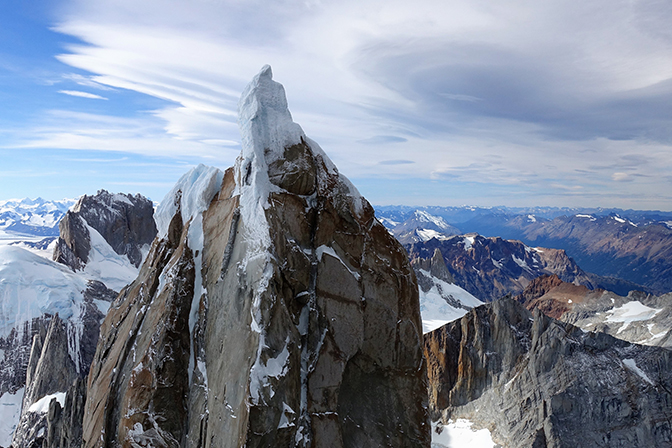
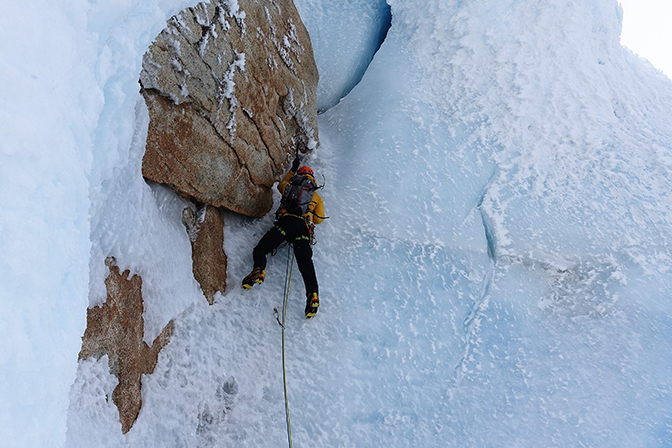
We woke, and Caleb led the climb across the steep snow ramp against Aguja Standhardt, where we abseiled into an ice gulley 50 meters below the base of Punta Herron. It was now light enough to see the broad rock ridge, the ‘Arete of the Children’, and the weather was still cooperating. ‘The Col of Dreams’ was our next landmark, but the conditions on arrival were closer to a nightmare. Fingers numbed in minutes, crampons skated on blank granite, ice picks wobbled in thin seams. Dry tooling (rock climbing with ice tools, gloves and crampons) was the only option in such cold conditions. This was the full-on Patagonian experience that we had craved, but could we stomach the reality?
Eventually, after hours of bone aching wind chill, the call came from Dan.
“Only one pitch to the summit!”
Our spirits lifted. Perhaps the summit of Punta Herron was within reach after all.
We charged towards the mushroom – the final hurdle. Turning the corner, we found plastic-blue ice leading up a natural tunnel formation, and with only a handful of ice screws remaining, Caleb was forced to run-out the last thirty metres, sinking his tools deep under a shower of falling ice.
We surfaced. Lungs heaving, voices laughing, bodies crouched and bracing to prevent ourselves from being blown off the summit. She chewed us up, but in that moment we felt a sliver of Punta Herron’s mercy. We had little time to soak it up – the descent would be hard.
Bad weather forced us to charge non-stop back to town. We descended – another marathon abseiling session, then trekked the glacier and moraines, and walked the streets of El Chalten 36 hours after we had left the relative comfort of our tent at Col Standhardt. We were wet, cold, sunburnt shells of men, eyes stinging and bloodshot from no sleep, bodies too numb to feel any sense of achievement. Then someone handed me a Quilmes Stout, and as the cold of the brew soothed my raw throat, I began to comprehend and appreciate what we had done.
Follow the New Zealand Alpine Team’s adventures on their blog, on Instagram and on Facebook.
